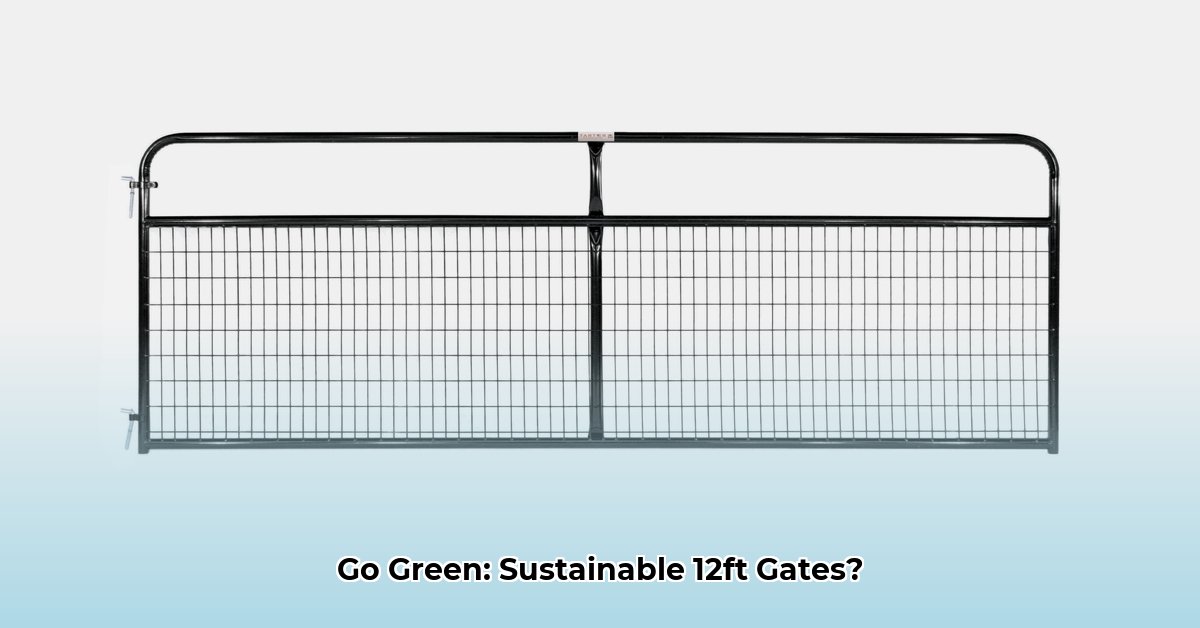
Choosing a 12-foot gate for your farm involves more than just selecting a size; it's a decision with long-term implications for both your farm's functionality and environmental footprint. This guide will help you navigate the options available at Tractor Supply and other retailers, focusing on sustainable choices that balance cost-effectiveness with environmental responsibility. For smaller gates, check out our guide on 5-foot gates.
Understanding Sustainable Gate Material Options
The market offers several materials for 12-foot farm gates, each with unique sustainability profiles. Let's examine the leading contenders: steel, recycled plastic, and sustainably harvested wood. Choosing the "best" option depends on your specific priorities – durability, initial cost, long-term maintenance, and environmental impact.
Steel Gates: Strength and Durability, but with Environmental Trade-offs
Steel gates are known for their robust strength and longevity. They can easily withstand years of heavy use and harsh weather conditions. However, steel production is energy-intensive, contributing significantly to carbon emissions.
- Pros: Exceptional durability (20+ year lifespan with proper maintenance), high strength, relatively low maintenance requirements (occasional repainting may be needed).
- Cons: High initial cost, significant environmental impact during manufacturing due to high energy consumption, susceptible to rust without appropriate coatings.
Recycled Plastic Gates: A Sustainable Alternative with Trade-offs
Recycled plastic gates offer a more environmentally friendly alternative to steel, diverting plastic waste from landfills. They are typically lighter than steel, making installation potentially easier.
- Pros: Lower environmental impact compared to steel, lower initial cost than steel, generally low maintenance.
- Cons: Potentially lower strength than steel, shorter lifespan (10-15 years), susceptibility to UV degradation and damage from extreme temperatures. End-of-life recycling options might be limited depending on your location.
Sustainably Harvested Wood Gates: Natural Aesthetics and Renewability
Sustainably harvested wood gates offer a visually appealing, natural option. However, their sustainability hinges on responsible sourcing practices. Always verify that the wood is certified by organizations like the Forest Stewardship Council (FSC) to ensure responsible forest management.
- Pros: Natural aesthetic appeal, renewable resource (if sustainably sourced), repairable, potentially lower initial cost compared to steel.
- Cons: Requires regular maintenance (staining, sealing to prevent rot and insect damage), susceptible to weathering and decay, shorter lifespan than steel if not properly maintained.
Total Cost of Ownership: A Long-Term Perspective
The initial purchase price is only one element of the overall cost. To make an informed decision, you must consider the total cost of ownership over the gate's lifespan. This includes the initial cost, annual maintenance expenses (including repairs and replacement parts), and the eventual replacement cost.
Example: (Note: These are illustrative estimates and may vary based on location, specific products, and other factors).
| Material | Initial Cost (USD) | Annual Maintenance (USD) | Lifespan (Years) | Replacement Cost (USD) | Total 10-Year Cost (USD) |
|---|---|---|---|---|---|
| Steel | 500 | 25 | 20 | 300 | 750 |
| Recycled Plastic | 300 | 50 | 10 | 250 | 850 |
| Sustainable Wood | 400 | 40 | 15 | 350 | 800 |
This data underscores that while initial costs vary, long-term maintenance significantly impacts the overall cost. Steel, despite its higher initial price, emerges as a more cost-effective option over a 10-year period in this example.
A Step-by-Step Guide to Choosing a Sustainable Gate
Assess Your Needs: Define your gate's function (livestock containment, security, etc.), frequency of use, and the environmental conditions it will face. Harsh climates may necessitate more durable materials.
Analyze Total Cost of Ownership: Calculate the estimated total cost of each material option over its expected lifespan. This should include initial purchase, maintenance, and eventual replacement.
Prioritize Sustainability: Opt for sustainably sourced materials whenever possible. Look for FSC certifications (for wood) and inquire about the origin of recycled plastic.
Research Tractor Supply Options: Thoroughly review the 12-foot gate options at Tractor Supply, comparing materials, warranties, and customer reviews.
Consult with Professionals: Seek advice from experienced farmers or agricultural specialists if you have any uncertainties.
Key Takeaways: Making a Sustainable Choice
Choosing a sustainable 12-foot farm gate requires careful consideration of various factors. Balancing upfront costs with long-term maintenance, lifespan, and environmental impact is crucial. By following these steps and prioritizing responsible sourcing, you can ensure your gate choice aligns with both your farm's needs and your commitment to sustainability. Remember that responsible stewardship extends beyond the initial purchase, encompassing proper installation, routine maintenance, and thoughtful disposal at the end of the gate’s life.